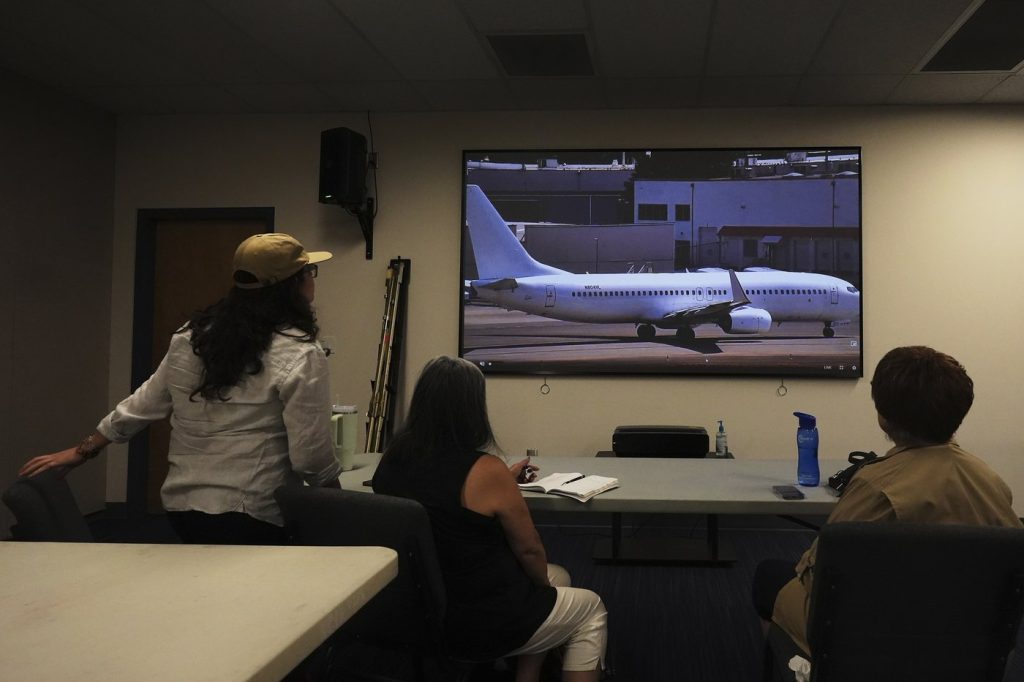SEATTLE (AP) — Immigration advocates regularly gather outside Seattle’s King County International Airport to monitor deportation flights and disseminate information regarding the routes and number of deportees on board. Previously, they utilized publicly accessible flight tracking websites to keep tabs on these flights. However, recent changes by airlines have led them to employ dummy call signs and block tail numbers from such tracking sites, making it increasingly challenging for advocates to obtain flight details.
The alteration in tracking methods comes at a time when deportation flights have surged to record high levels, particularly during the presidency of Donald Trump. This has compelled advocates to rely on collaborative information sharing and data from open-source aircraft transmission exchanges to trace deportation activities, ultimately assisting families in locating deported loved ones. The lack of transparency from U.S. Immigration and Customs Enforcement (ICE), which seldom provides flight information, only intensifies the advocates' efforts.
Tom Cartwright, a retired J.P. Morgan financial officer turned immigration advocate, has recorded a staggering 1,214 deportation-related flights in July 2023 — marking his busiest period since he began tracking in January 2020. Approximately 80% of these flights are operated by three airlines: GlobalX, Eastern Air Express, and Avelo Airlines. They transport immigrants either to airports for transfer to overseas flights or directly across the border, predominantly targeting Central America and Mexico.
From the onset of Trump’s second term through July 2023, Cartwright documented 5,962 flights related to deportations, representing a 41% increase from 1,721 during the same timeframe the previous year. His figures also accounted for 68 military deportation flights since January, with 18 occurring in July alone, the majority heading to Guantánamo Bay, Cuba. Due to the increasing demands of tracking these flights, Cartwright's organization, Witness at the Border, has recently handed over its responsibilities to Human Rights First, which has since launched its project, “ICE Flight Monitor.”
Human Rights First's CEO, Uzrz Zeya, applauded Cartwright's contributions, emphasizing the vital role his work plays in providing crucial transparency regarding U.S. government actions that affect thousands of lives. Unfortunately, airlines have not responded to repeated inquiries regarding their operational changes related to flight tracking, and ICE, which falls under the Department of Homeland Security, has refrained from confirming any additional security measures.
The Seattle-based nonprofit La Resistencia has been actively monitoring deportation activities, recording 59 flights at Boeing Field and five at Yakima Airport in 2023, surpassing its 2022 total of 42. While not all monitored flights are deportation-related, many facilitate the transfer of immigrants to or from detention facilities. La Resistencia reported that 1,023 immigrants were flown to the ICE detention center in Tacoma, Washington, while another 2,279 were transported out, frequently to states along the U.S.-Mexico border. Guadalupe Gonzalez, an organizer with La Resistencia, remarked on ICE’s efforts to obfuscate its activities and make it considerably more difficult to distinguish between government operations and commercial airline activities.
Airlines Can Legally Block Data
The Federal Aviation Administration allows airlines to restrict data, including tail numbers, from public flight tracking services via the Limiting Aircraft Data Displayed (LADD) program. Ian Petchenik, a spokesman for FlightRadar24, likened tail numbers to vehicle identification numbers, emphasizing their importance for tracking flights. Aircraft that have blocked tail numbers no longer appear on platforms like FlightRadar24 or FlightAware, with their tracking information marked as “N/A – Not Available.” In a notable shift, FlightRadar24 reported that it received LADD notices for over a dozen aircraft in March, which was atypical given the number of aircraft being blocked by various carriers, especially those used for ICE deportations.
Moreover, airlines have altered their call signs, making it increasingly challenging for advocates to trace flights associated with immigration activities. For instance, GlobalX previously utilized the call sign “GXA.” However, recent changes have obscured the identification process for these flights.
Cameras at Boeing Field Aid Volunteers in Tracking Flights
King County International Airport is uniquely positioned as one of the few locations where advocates can visually monitor the boarding and disembarking of passengers due to county-operated surveillance cameras. Volunteers diligently document each flight's arrival, counting the number of individuals and noting any visible struggles during the boarding process.
ICE operations at Boeing Field began in 2011, but the county implemented cameras on the tarmac in 2023 following an order from King County Executive Dow Constantine, who sought to track these flights despite having previously attempted to halt them. Monthly statistics regarding ICE flights are now made publicly available by the county.
The cameras capture footage of immigrants arriving on buses, undergoing searches, and ascending the stairs to the planes. Recently documented was the experience of a man who, hindered by a cane, struggled to navigate the boarding stairs with his ankles and wrists chained, reflecting the severe restrictions detainees face. In addition to monitoring patterns and conditions, a livestream of this activity is broadcasted on a giant screen at a nearby building and also available on the county website.
Advocates like Stan Shikuma relay the rigorous procedures detainees experience, from exhaustive pat-downs to further tightening of restraints before boarding. Such monitoring emphasizes the heavy scrutiny under which deportation proceedings operate, highlighting the human aspect behind the statistics.












